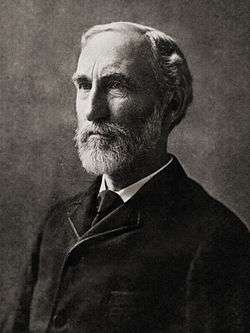Gibbs' inequality
In information theory, Gibbs' inequality is a statement about the mathematical entropy of a discrete probability distribution. Several other bounds on the entropy of probability distributions are derived from Gibbs' inequality, including Fano's inequality. It was first presented by J. Willard Gibbs in the 19th century.

Gibbs' inequality
Suppose that
is a probability distribution. Then for any other probability distribution
the following inequality between positive quantities (since pi and qi are between zero and one) holds:[1]:68
with equality if and only if
for all i. Put in words, the information entropy of a distribution P is less than or equal to its cross entropy with any other distribution Q.
The difference between the two quantities is the Kullback–Leibler divergence or relative entropy, so the inequality can also be written:[2]:34
Note that the use of base-2 logarithms is optional, and allows one to refer to the quantity on each side of the inequality as an "average surprisal" measured in bits.
Proof
For simplicity, we prove the statement using the natural logarithm (ln), since
the particular logarithm we choose only scales the relationship.
Let denote the set of all for which pi is non-zero. Then, since for all x > 0, with equality if and only if x=1, we have:
The last inequality is a consequence of the pi and qi being part of a probability distribution. Specifically, the sum of all non-zero values is 1. Some non-zero qi, however, may have been excluded since the choice of indices is conditioned upon the pi being non-zero. Therefore the sum of the qi may be less than 1.
So far, over the index set , we have:
- ,
or equivalently
- .
Both sums can be extended to all , i.e. including , by recalling that the expression tends to 0 as tends to 0, and tends to as tends to 0. We arrive at
For equality to hold, we require
- for all so that the equality holds,
- and which means if , that is, if .
This can happen if and only if for .
Alternative proofs
The result can alternatively be proved using Jensen's inequality, the log sum inequality, or the fact that the Kullback-Leibler divergence is a form of Bregman divergence. Below we give a proof based on Jensen's inequality:
Because log is a concave function, we have that:
Where the first inequality is due to Jensen's inequality, and the last equality is because is a probability distribution.
Furthermore, since is strictly concave, by the equality condition of Jensen's inequality we get equality when
Suppose that this ratio is , then we have that
Where we use the fact that are probability distributions. Therefore the equality happens when .
See also
- Information entropy
- Bregman divergence
References
- Pierre Bremaud (6 December 2012). An Introduction to Probabilistic Modeling. Springer Science & Business Media. ISBN 978-1-4612-1046-7.
- David J. C. MacKay. Information Theory, Inference and Learning Algorithms. Cambridge University Press. ISBN 978-0-521-64298-9.